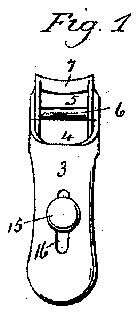
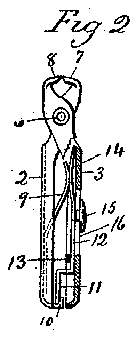
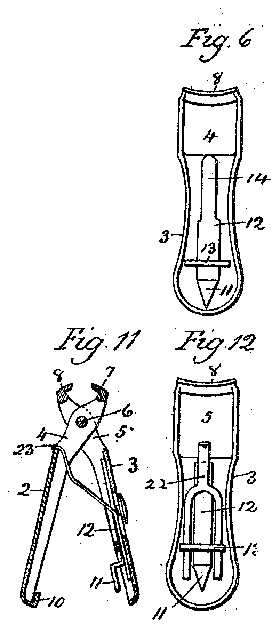
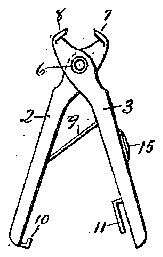
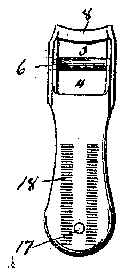
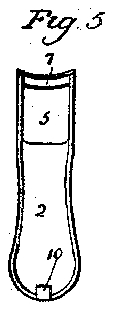
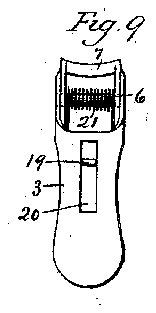
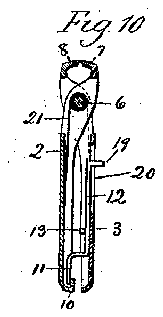
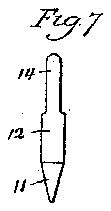
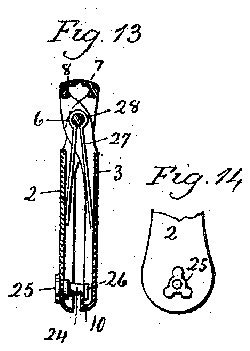
- 2lever members
- 3lever members
- 5large clearance-openings
- 6pivot
- 8integral cutters
- 9spring
- 10locking-lug
- 11nail-cleaner
- 12slide
- 14frictionspring
- 15button
- 16slot
- 17rivet
- 19operating-finger
- 20wide slot
- 21spiral spring
- 22operating-spring
- 23hook
- 24rotary post
- 25triangular finger-piece
- 26cam
- 27operating-spring
- 28sleeve
Description
PATENTED AUG. 22, 1905.
0. S. CARTER. FINGER 'NAIL TRIMMER.
APPLICATION FILED MAY 15, 1906.
I 7/ ZZZ/.2
muntw B unmm c0. mmumoMAmmm WAWGYOI, n c.
Unrrnn STATES PATENT OFFICE.
CHAPEL S. CARTER, OF ANSONIA, CONNECTICUT, ASSIGNOR TO THE H. C. COOK CO., OF ANSONIA, CONNECTICUT, A CORPORATION- FINGER-NAIL TRIMMER.
Specification of Letters Patent.
Patented Aug. 22, 1905.
Application filed May 15, 1905. Serial No. 260,423.
To all whom it nuty concern;
Be it known th at LCHAPEL S. CARTER, a citizen of the United States, residing at Ansonia, in the county of New Haven and State of Connecticut, have invented a new and useful Improvement in Finger-Nail Trimmers; and I do hereby declare the following, when taken in connection with the accompanying drawings and the numerals of reference marked thereon, to be a full, clear, and exact description of the same, and which said drawings constitute part of this specification, and represent, in-
Figure 1, a plan view of a finger-nail trimmer constructed in accordance with my invention; Fig. 2, a view thereof, partly in side elevation and partly in longitudinal section and shown as closed; Fig. 3, a View thereof in side elevation, shown as open; Fig. 4, a reverse plan view thereof; Fig. 5, a detached view in inside elevation of the lever member provided with an integral locking-lug; Fig. 6, a corresponding view of the other lever member to which the locking-slide is applied; Fig. 7 a detached plan view of the lockingslide; Fig. 8, an edge view thereof; Fig. 9, a plan View of one of the modified forms which the device may assume; Fig. 10, a view thereof in longitudinal section; Fig. 11, a view in longitudinal section of another form which my improved device may assume; Fig. 12, a detached view, in inside elevation, of one of the two members of the device of Fig. 11; Fig. 13, a view in longitudinal section of still another form which my improved device may assume; Fig. 14:, a broken plan view of the handle end of one of the two members of the device of Fig. 13; Fig. 15, a detached plan view of the cam upon the locking-stud forming a feature of the device of Figs. 13 and 1 1.
My invention relates to an improvement in finger-nail trimmers of the plier type, the object being to produce at a low cost for manufacture a simple, compact, and efiective appliance constructed with particular reference to ease and convenience of operation and durability in use.
With these ends in view my invention consists in a finger-nail trimmer of the plier type having certain details of construction and combinations of parts, as will be hereinafter described, and pointed out in the claims.
In carrying out my invention as shown in F1gs.l to 8, 1nclus1ve,of the drawings I employ two struck-up sheet-metal lever members 2 and 3,flanged or cupped to increase their rigidity and having their cutting ends respectively formed with large clearance-openings 4 and 5, adapting one member to be passed through the other plierwise. The-said lever members are connected by a pivot 6 passing through the said clearance-openings and located relatively near the integral cutters 7 and 8, which are concaved to conform to the curvature of the finger-nails. For holding the lever members together against the tension of the spring 9, which constantly tends to throw them apart, I provide the member 2, at the center of its handle end, with an integral inwardly-turned locking-lug 10, adapted to be engaged by the end of a pointed nail-cleaner 11,inwardly off set from the outer end of a locking-slide 12, located within the lever member 3 and sliding back and forth under a bridge or staple 13, located within the same. The inner end of the slide 12 is bowed to form a frictionspring 14:, which restrains its endwise movement and holds it in place. The slide is operated by means of a button 15, located upon the outer face of the lever member 3 and having its shank passed through a slot 16 therein and into the slide, to which it is thus secured.
After the user of the device has finished using it he will close the lever members 2 and 3 against the tension of the spring 9 and use the button 15 for shoving the slide outward, so as to engage the point of the nail-cleaner 11 with the locking-lug 10, as shown in Fig. 2. On the other hand, if he desires to use the nail-cleaner 11 the same is disengaged from the lug 10 by shoving the button 15 inward and allowing the spring 9 to separate the lever members 2 and 3, after which the slide 12 is again shoved outward by its button 13, whereby its nail-cleaner 11 will be projected beyond the rounded handle end of the lever member 3. The spring 9 aforesaid is mounted in the lever member 2, to which it is secured by a rivet 17; but the form and arrangement of this spring may obviously be varied.
As shown in Fig. 4, the outer face of the lever member 2 is roughened, as at 18, to serve as a file.
In the modified construction shown by Figs. 9 and 10 of the drawings the lever members 2 and 3 have substantially the construction already described; but the slide 12 instead of being operated by a button has its inner end turned outward to form an operating-finger 19, which projects through a wide slot 20, formed in the lever member 3. In this modified construction the slide has the same nailcleaner 11 which engages with an inwardlyturned locking-lug 10, formed integral with the lever member 2. In this modified construction also instead of employing a fiat spring 9 I employ a spiral spring 21, encircling the pivot 6 and having its respective ends engaged with the inner faces of the lever members 2 and 3.
In the modified construction shown by Figs. 11 and 12 the lever members 2 and 3 have the same or substantially the same construction as those before described, as well-as the slide 12 with its inwardly-offset nail-cleaner 11 for engagement with an inwardly-turned lockinglug 10, formed integral with the lever member 2. In this construction, however, the operating-spring 22 is mounted in the lever member 3, its fork-like inner portion embracing the slide 12 and its free outer end being extended through the clearance-opening 4 of the lever member 2 and bent to form a hook 23, which grips the inner edge of the said opening, Fig. 11, so as to prevent the two lever members from flying apart to too great a distance under the pressure of the spring, which is held in place by the bridge 13.
In the modified construction shown by Figs. 13 to 15, inclusive, the lever members 2 and 3 are of substantially the construction elsewhere shown; but instead of employing a lockingslide I employ a rotary post 24, journaled in the lever member 2 and rotated by means of a triangular finger-piece 25, bearing upon the outer face of the said lever member. At its inner end the post is formed with a cam 26, engaging with an inwardly-turned integral locking-lug 10, formed in this instance upon the lever member 3. In this construction the operating-spring 27 consists of a fiat strip of sheet metal bent midway of its length to form a sleeve 28 to embrace the pivot 6, whereby it is held in place, the respective ends of the spring engaging with the inner face of the respective lever members 2 and 3.
Having fully described my invention, what I claim as new, and desire to secure by Letters Patent, is
1. In a finger-nail trimmer, the'combination with two lever members pivotally connected together plierwise, one member being provided at its handle end with an inwardly-extending locking-lug; of a movable fastening device mounted in the other member for engagement with the said lug, whereby the two lever members are held in their closed positions.
2. In a finger-nail trimmer, the combination with two lever members pivotally connected together plierwise, one member being provided at its handle end with an inwardly-extending locking-lug; of a locking-slide applied to the other member and engaging with the said lug for holding the two members in theirclosed positions.
3. In afinger-nail trimmer, the combination I CHAPEL S. CARTER.
Witnesses:
CLARA L. WEED, GEORGE D. SEYMOUR.